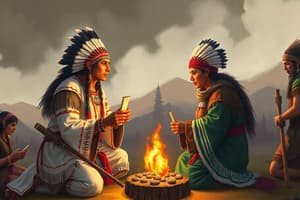Podcast
Questions and Answers
In which year was the Indian Act first passed?
In which year was the Indian Act first passed?
- 1951
- 1876 (correct)
- 1982
- 1867
The Indian Act was voluntarily negotiated by Aboriginal peoples.
The Indian Act was voluntarily negotiated by Aboriginal peoples.
False (B)
What was the primary purpose of enfranchisement for Indigenous individuals in Canada?
What was the primary purpose of enfranchisement for Indigenous individuals in Canada?
- To promote cultural preservation
- To enhance community ties among Indigenous peoples
- To provide government support for Indigenous communities
- To grant citizenship rights under Canadian law (correct)
Enfranchisement allowed Indigenous peoples to maintain their culture and language.
Enfranchisement allowed Indigenous peoples to maintain their culture and language.
What was one purpose of the Indian Act?
What was one purpose of the Indian Act?
What did forced enfranchisement require Indigenous peoples to abandon?
What did forced enfranchisement require Indigenous peoples to abandon?
The Indian Act was reworked in _____ after WWII.
The Indian Act was reworked in _____ after WWII.
Match the following years with their significance regarding the Indian Act:
Match the following years with their significance regarding the Indian Act:
Enfranchisement was a way to decrease expenses by removing government __________.
Enfranchisement was a way to decrease expenses by removing government __________.
Match the following terms with their descriptions:
Match the following terms with their descriptions:
What is the purpose of treaties for aboriginal people?
What is the purpose of treaties for aboriginal people?
Unceded land refers to land taken by settlers without compensation.
Unceded land refers to land taken by settlers without compensation.
What are peace and friendship treaties primarily concerned with?
What are peace and friendship treaties primarily concerned with?
The Numbered Treaties were agreements between the Crown and __________.
The Numbered Treaties were agreements between the Crown and __________.
Match the following elements with their corresponding descriptions:
Match the following elements with their corresponding descriptions:
Which of the following is NOT a promise made by treaties to Indigenous people?
Which of the following is NOT a promise made by treaties to Indigenous people?
Treaties are only important for aboriginal people.
Treaties are only important for aboriginal people.
What did the British do to formalize guarantees made in treaties?
What did the British do to formalize guarantees made in treaties?
What percentage of Canada is covered by modern treaties?
What percentage of Canada is covered by modern treaties?
All treaties have expired and are no longer in effect.
All treaties have expired and are no longer in effect.
What was the main aim of early treaties between indigenous peoples and lawmakers?
What was the main aim of early treaties between indigenous peoples and lawmakers?
Treaties guarantee rights to land, culture, and practices like __________ and fishing.
Treaties guarantee rights to land, culture, and practices like __________ and fishing.
Match the following outcomes with their associated consequences or rights loss:
Match the following outcomes with their associated consequences or rights loss:
What did the Royal Proclamation of 1763 establish regarding land ownership?
What did the Royal Proclamation of 1763 establish regarding land ownership?
What term was used to describe the legislative actions aimed at 'civilizing' indigenous peoples?
What term was used to describe the legislative actions aimed at 'civilizing' indigenous peoples?
What was the main goal of the White Paper released by Prime Minister Pierre Trudeau?
What was the main goal of the White Paper released by Prime Minister Pierre Trudeau?
The constitution Act of 1867 established Canada as a federation.
The constitution Act of 1867 established Canada as a federation.
The Indian Act changes in the 1980s marked the beginning of enfranchisement.
The Indian Act changes in the 1980s marked the beginning of enfranchisement.
What was the primary responsibility of the federal government concerning aboriginal peoples after 1867?
What was the primary responsibility of the federal government concerning aboriginal peoples after 1867?
What does it imply when treaties are described as 'living documents'?
What does it imply when treaties are described as 'living documents'?
Indian women marrying non-Indians lost their Indian status under the amended Indian Act.
Indian women marrying non-Indians lost their Indian status under the amended Indian Act.
What authority did the Indian agent have over the Band Council?
What authority did the Indian agent have over the Band Council?
The treaties misrepresented the _______ agreements between indigenous leaders and the British.
The treaties misrepresented the _______ agreements between indigenous leaders and the British.
Match the following descriptions with their corresponding terms:
Match the following descriptions with their corresponding terms:
The Indian Act was amended in _____ after World War II to address issues of poverty and discrimination faced by Aboriginal peoples.
The Indian Act was amended in _____ after World War II to address issues of poverty and discrimination faced by Aboriginal peoples.
Match the following clauses of the Indian Act with their descriptions:
Match the following clauses of the Indian Act with their descriptions:
What misunderstanding did indigenous leaders face during treaty negotiations?
What misunderstanding did indigenous leaders face during treaty negotiations?
All terms of the treaties were clearly understood and agreed upon by indigenous leaders.
All terms of the treaties were clearly understood and agreed upon by indigenous leaders.
What change was made regarding the Band Council residency under the amended Indian Act?
What change was made regarding the Band Council residency under the amended Indian Act?
The Indian agent had the authority to remove Band Council members.
The Indian agent had the authority to remove Band Council members.
What did indigenous peoples understand was being surrendered during treaty negotiations?
What did indigenous peoples understand was being surrendered during treaty negotiations?
What was one impact of the rule regarding loss of Indian status?
What was one impact of the rule regarding loss of Indian status?
Flashcards
Treaty
Treaty
A formal agreement between two or more parties, often involving land rights and other important issues.
Peace and Friendship Treaties
Peace and Friendship Treaties
Agreements signed between the Crown and Indigenous Nations to secure allies or ensure neutrality.
Numbered Treaties
Numbered Treaties
Eleven agreements made between the Crown and First Nations from 1871 to 1921, primarily in Western Canada.
Unceded Land
Unceded Land
Signup and view all the flashcards
Why are treaties important to Indigenous people?
Why are treaties important to Indigenous people?
Signup and view all the flashcards
Why are treaties important to non-Indigenous people?
Why are treaties important to non-Indigenous people?
Signup and view all the flashcards
What did the Numbered Treaties promise?
What did the Numbered Treaties promise?
Signup and view all the flashcards
What is the significance of unceded land?
What is the significance of unceded land?
Signup and view all the flashcards
Enfranchisement
Enfranchisement
Signup and view all the flashcards
Forced Enfranchisement
Forced Enfranchisement
Signup and view all the flashcards
Why was Enfranchisement promoted?
Why was Enfranchisement promoted?
Signup and view all the flashcards
Impact of Enfranchisement
Impact of Enfranchisement
Signup and view all the flashcards
Assimilation
Assimilation
Signup and view all the flashcards
Confederation
Confederation
Signup and view all the flashcards
Treaty Negotiation
Treaty Negotiation
Signup and view all the flashcards
Royal Proclamation of 1763
Royal Proclamation of 1763
Signup and view all the flashcards
Misrepresentation in Treaty Terms
Misrepresentation in Treaty Terms
Signup and view all the flashcards
Oral Agreements vs. Written Terms
Oral Agreements vs. Written Terms
Signup and view all the flashcards
Land Surrendered
Land Surrendered
Signup and view all the flashcards
Topsoil
Topsoil
Signup and view all the flashcards
Sharing Land
Sharing Land
Signup and view all the flashcards
Treaty Rights
Treaty Rights
Signup and view all the flashcards
Indigenous Land Ownership
Indigenous Land Ownership
Signup and view all the flashcards
Resource Management
Resource Management
Signup and view all the flashcards
Modern Treaty Impacts
Modern Treaty Impacts
Signup and view all the flashcards
Treaty Interpretation
Treaty Interpretation
Signup and view all the flashcards
End of Enfranchisement
End of Enfranchisement
Signup and view all the flashcards
What is the goal of the Indian Act?
What is the goal of the Indian Act?
Signup and view all the flashcards
When was the Indian Act first passed?
When was the Indian Act first passed?
Signup and view all the flashcards
Indian Act
Indian Act
Signup and view all the flashcards
Why was the Indian Act revised in 1951?
Why was the Indian Act revised in 1951?
Signup and view all the flashcards
Indian Agent
Indian Agent
Signup and view all the flashcards
What does 'paternalistic' mean in the context of the Indian Act?
What does 'paternalistic' mean in the context of the Indian Act?
Signup and view all the flashcards
Why is the Indian Act still in existence?
Why is the Indian Act still in existence?
Signup and view all the flashcards
The White Paper
The White Paper
Signup and view all the flashcards
Potlatch
Potlatch
Signup and view all the flashcards
Sun Dance
Sun Dance
Signup and view all the flashcards
Indian Status
Indian Status
Signup and view all the flashcards
Study Notes
Treaties and Indian Act
- Treaties are vital to Indigenous peoples, guaranteeing rights to land, culture (like hunting and fishing), and demonstrating the existence of nations and their rights. Treaties are also important to non-Indigenous peoples, outlining Canada's obligations to Indigenous groups and land use rules for settlers.
Peace and Friendship Treaties
- These agreements, signed between settlers and Indigenous groups, aimed to secure fighting alliances or guarantee Indigenous neutrality during conflicts.
- The British formalized these agreements by writing them down.
- A significant example is the 1752 agreement signed by the Mi'kmaq grand chief, Jean Baptiste Cope.
Numbered Treaties
- Eleven agreements between the Crown and First Nations (1871-1921)
- Allowed settlers to use land from western Ontario to the Yukon.
- Treaties often promised reserves, money, and hunting/fishing rights.
Unceded Land
- Land taken by settlers without compensation.
Cultural Assimilation
- The process of adopting the dominant culture.
Forced Assimilation
- Enforced cultural change.
Confederation
- A total of 31 treaties were signed involving Indigenous peoples and the Crown
Annuities
- Annual payments given to Indigenous peoples by the government.
Constitution Act 1867
- Established Canada as a confederation, assigning responsibility for Indigenous peoples and reserves to the federal government.
Royal Proclamation 1763
- Instructed British settlers regarding land settlement.
- Declared Indigenous peoples had existing claims to land and that agreements for land purchase were required from the Crown.
Enfranchisement
- The process where Indigenous people surrendered their Indigenous status to become British subjects, losing treaty rights and benefits.
Indian Act Amendments
- The Indian Act saw major revisions in 1951 due to public awareness of Indigenous poverty and discrimination.
Indian Agent
- Representatives of the federal government responsible for enforcing policies related to Indigenous peoples.
The White Paper
- A policy proposal to eliminate Indian status and treaties, transferring responsibility for Indigenous peoples to provinces; it was not implemented because of public and Indigenous opposition.
Indian Act's Purpose
- The Indian Act was created to consolidate laws for Indigenous peoples and maintain order between them and non-Indigenous groups.
- Its purpose was heavily influenced by assimilationist pressures, aiming to assimilate Indigenous peoples into Canadian culture.
Modern Treaties
- Address Indigenous land ownership, financial transfers, and resource management.
- They cover around 40% of Canada's land.
Treaty Expiry
- Treaties are not expired, rather regarded as living documents that are actively debated and interpreted.
Early Treaties
- Based on respect and peaceful coexistence.
- Later treaties justify Indigenous enslavement and policies that led to cultural suppression.
Studying That Suits You
Use AI to generate personalized quizzes and flashcards to suit your learning preferences.



